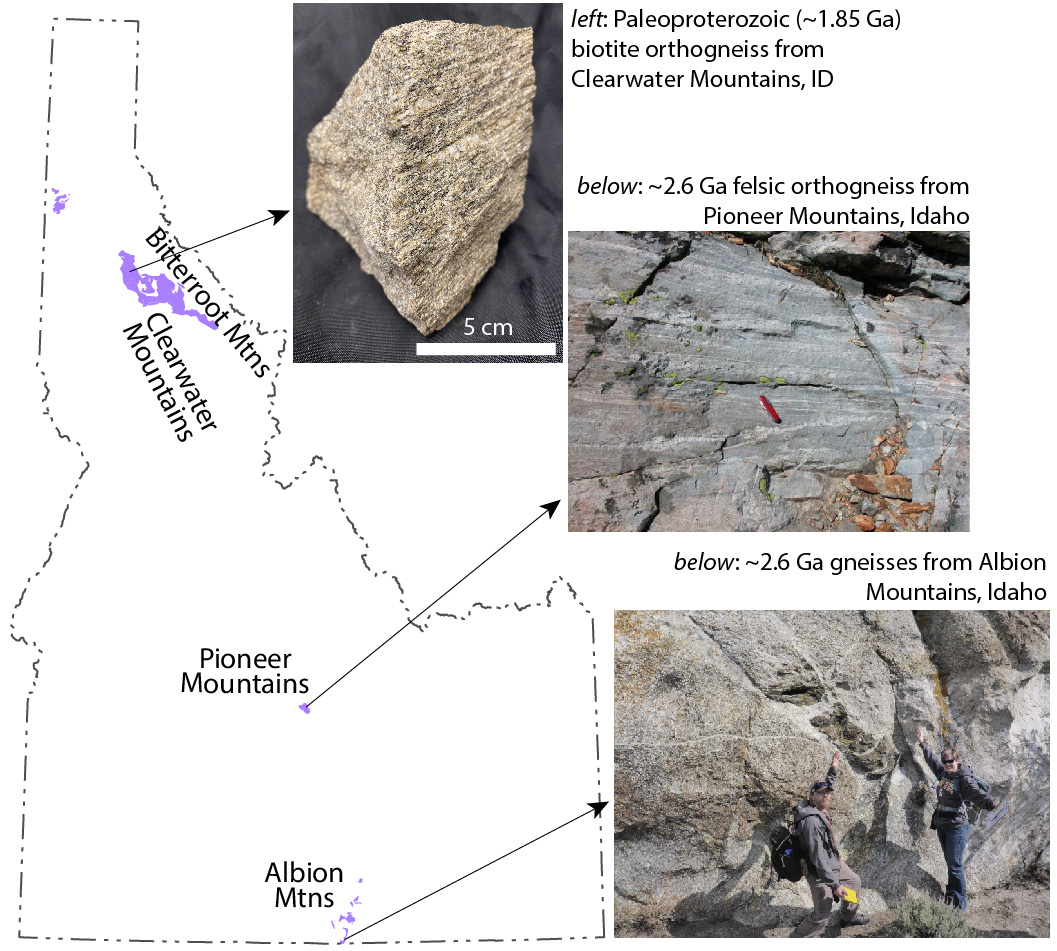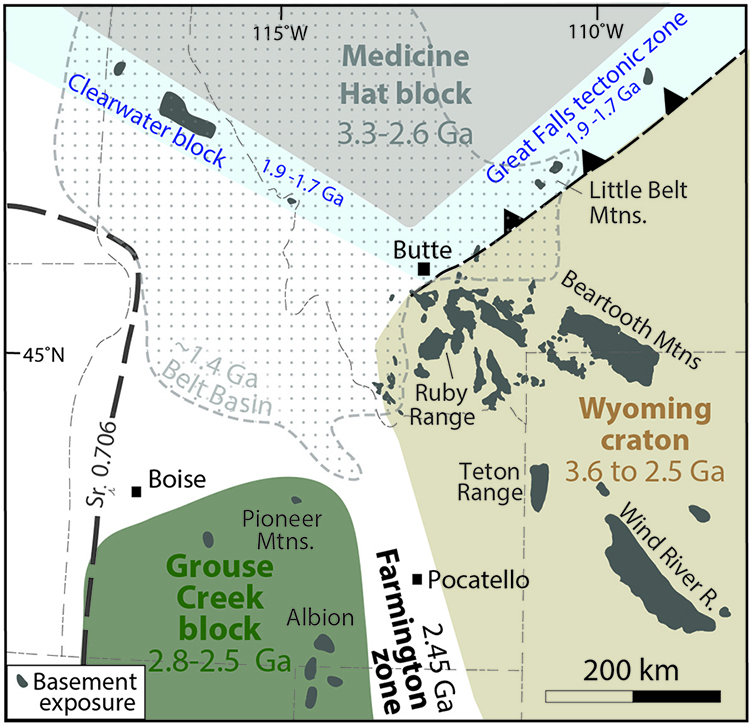Basement rocks of Idaho
The oldest rocks that make up the Earth's crust are called "basement." These basement rocks consist of medium- to coarse-grained igneous and metamorphic rocks that are assumed to make up much of the middle and lower crust, even where they are not exposed.
PDF slideshows by Laura DeGrey-Ellis and Paul Link: Albions slides, Tetons slides, Pioneers slides.
Basement exposures

In Idaho, basement rocks range in age from Archean (>2.5 Ga) to Paleoproterozoic (2.5-1.6 Ga) in age and are only exposed at the surface in a few isolated mountain ranges, including in the Albion Range and Pioneer Mountains. Above map modified from Lewis et al. (2012) and Pioneer Mountains gneiss photo from Durk (2007).
Basement provinces of the northern Rocky Mountains

Map showing exposures of basement rocks (small dark blobs) and inferred basement provinces (colored blobs) in the northern Rocky Mountains (modified from Mogk et al., 2020).
The basement provinces in the above figure are based primarily upon geochronology of exposed basement rocks and have been tentatively extrapolated to include larger regions. The main basement provinces inferred within and adjacent to Idaho were described by Foster et al. (2006) and are summarized below.
- Wyoming craton: The oldest rocks in the northern Rocky Mountains and some of the oldest in North America occur in the Wyoming craton. These rocks are not exposed in Idaho but are inferred to be present at depth beneath eastern Idaho. U-Pb zircon geochronology from rocks in Wyoming and southwestern Montana indicates that rocks of the Wyoming province are up to ~3.8 Ga. The Wyoming province has been subdivided into the Bighorn subprovince and Montana Metasedimentary province. These rocks were intruded by younger magmas, metamorphosed, and deformed, particularly during ~2.9-2.5 Ga and ~1.8 Ga. Geochemistry of these rocks suggests that plate tectonics may have initiated in this region (and globally?) at ~2.7 Ga. For further information about the southern Wyoming craton, see Chamberlain et al. (2003) and Frost et al. (2006). For more information about the Montana Metasedimentary province, see Mogk et al. (2020).
- Grouse Creek block: The Grouse Creek block is exposed in the Albion Mountains of southern Idaho and the Pioneer Mountains of central Idaho and contains rocks as old as ~2.6 Ga. It is inferred to exist at depth beneath much of southwestern Idaho due to apparent remelting of Grouse Creek rocks during emplacement of the Idaho batholith (Gaschnig et al., 2013). The Grouse Creek block is similar in age to parts of the Wyoming craton and may have been originally connected to it prior to apparent ~2.45 Ga rifting between the two within the Farmington zone, followed by re-attachment to the Wyoming craton during Paleoproterozoic (~1.7 Ga) orogenesis (Foster et al., 2006; Mueller et al., 2011). For further information about basement rocks in the Pioneer Mountains, see Link et al. (2017). More information about basement in the Albion Mountains can be found in Strickland et al. (2011).
- Medicine Hat block: The Medicine Hat block is not exposed at the Earth's surface but is defined on the basis of geochronology from drill cores in southern Canada (Villeneuve et al., 2003). Its boundaries were extrapolated into northern Idaho and Montana on the basis of geophysical data. Geochronology of drill core samples from within the Medicine Hat block suggests rocks as old as ~3.3 Ga. Similarly to the Grouse Creek block, the Medicine Hat block may have originally been a part of the Wyoming craton prior to Early Paleoproterozoic rifting. It was apparently juxtaposed against the northwestern Wyoming craton (Gifford et al., 2020) during 1.9-1.8 Ga ocean basin closure of the Great Falls orogeny and subsequent ~1.8-1.7 Ga collision during the Big Sky orogeny (Harms et al., 2004).
Many of the pieces that constitute the North American craton were amalgamated at ~1.9-1.7 Ga during widespread orogenesis throughout North America concurrent with the Trans-Hudson orogeny. Magmatism and metamorphism of this age are preserved within the Great Falls tectonic zone and Clearwater block.
Continue to Module 2 - Belt Supergroup
References and further reading
Chamberlain, K.R., Frost, C.D., and Frost, B.R., 2003, Early Archean to Mesoproterozoic evolution of the Wyoming Province: Archean origins to modern lithospheric architecture: Canadian Journal of Earth Sciences, v. 40, p. 1357–1374.
Durk, K., 2007, Geochronology of part of the Wildhorse Gneiss complex, Pioneer Mountains, Custer County Idaho [senior thesis]: Pocatello, Idaho State University, 38 p.
Foster, D.A., Mueller, P.A., Mogk, D.W., Wooden, J.L., and Vogl, J.J., 2006, Proterozoic evolution of the western margin of the Wyoming craton: implications for the tectonic and magmatic evolution of the northern Rocky Mountains: Canadian Journal of Earth Sciences, v. 43, p. 1601–1619.
Frost, C.D., Fruchey, B.L., Chamberlain, K.R., and Frost, B.R., 2006, Archean crustal growth by lateral accretion of juvenile supracrustal belts in the south-central Wyoming Province: Canadian Journal of Earth Sciences, v. 43, p. 1533–1555.
Gaschnig, R.M., Vervoort, J.D., Lewis, R.S., and Tikoff, B., 2013, Probing for Proterozoic and Archean crust in the northern U.S. Cordillera with inherited zircon from the Idaho batholith: Geological Society of America Bulletin, v. 125, p. 73–88.
Gifford, J.N., Malone, S.J., and Mueller, P.A., 2020, The Medicine Hat Block and the Early Paleoproterozoic Assembly of Western Laurentia: Geosciences, v. 10, p. 271–21.
Lewis, R.S., Link, P.K., Stanford, L.R., and Long, S.P., 2012, Geologic map of Idaho: Idaho Geological Survey Map M-9: scale 1:750,000.
Link, P.K., Autenrieth-Durk, K.M., Cameron, A., Fanning, C.M., Vogl, J.J., and Foster, D.A., 2017, U-Pb zircon ages of the Wildhorse gneiss, Pioneer Mountains, south-central Idaho, and tectonic implications: Geosphere, v. 13, p. 681–698.
Mogk, D.W., Mueller, P.A., and Henry, D.J., 2020, The Archean geology of Montana: Montana Bureau of Mines Special Publication.
Mueller, P.A., Wooden, J.L., Mogk, D.W., and Foster, D.A., 2011, Paleoproterozoic evolution of the Farmington zone: Implications for terrane accretion in southwestern Laurentia: Lithosphere, v. 3, p. 401–408.
Strickland, A., Miller, E.L., and Wooden, J.L., 2011, The Timing of Tertiary Metamorphism and Deformation in the Albion–Raft River–Grouse Creek Metamorphic Core Complex, Utah and Idaho: The Journal of Geology, v. 119, p. 185–206.
Villeneuve, M.E., Ross, G.M., Thériault, R.J., Miles, W., Parrish, R.R., and Broome, J., 1993, Tectonic subdivision and U-Pb geochronology of the crystalline basement of the Alberta basin, western Canada: Geological Survey of Canada Bulletin, v. 447.
Credits
This page was compiled by Dave Pearson at Idaho State University.
